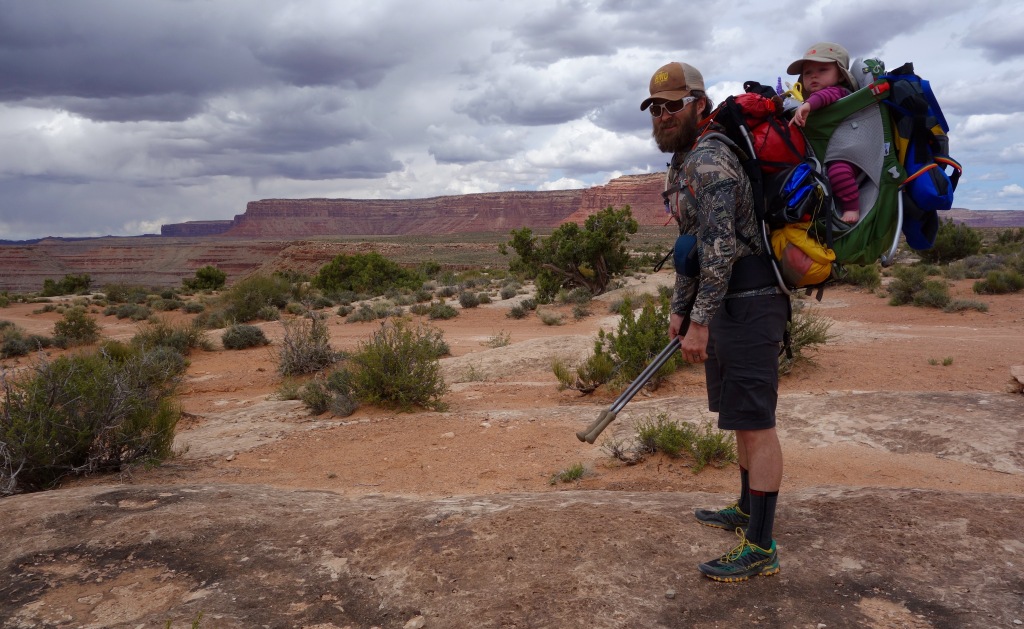The close of a decade approaches which, if you’re not stocking it with thinly context’d affiliate links, isn’t so bad an arbitrary cause to re-examine what has happened in the past 10 years. Lists focus the mind, and the fingers. The best of these use material goods as a vehicle to examine culture, and since hiking and backpacking media is boring as fuck compared to bike media, in the name of all us impoverished, sedate walkers I’ll aspire to that end here. First, a list just for backpacks, my favorite, and later a more general accounting.
Kifaru Bikini frame
The most sustained place for development in backpacks the past decade has been in hunting load haulers. Kifaru doesn’t make the Bikini frame anymore, but it still stands out as the apotheosis of the original Lowe internal suspension design; enough vertical structure to support 100 pounds, enough fabric and padding to keep it comfortable, and just enough else to keep it all held together. The limits of the Bikini have to do with adding lateral stability without adding too much weight, and the inevitable weight and comfort limitations associated with stay-in-lumbar designs.
Kifaru’s short-lived KU series was a contender here, with an integrated frame and bag making it to this day the lightest load hauling pack ever (2 lbs 10 oz for 5200 cubic inches). The suspension was at least as bold a design choice as the more obvious main bag fabric (dual layer sil) and minimal features, and I still wonder if the limits of the KU, with even less lateral stability than the bikini, had more to do with its short life at retail than the fragile fabric.
Seek Outside Unaweep 3900

If Kifaru set the table for the modern hunting pack, Seek Outside (nee Paradox Packs) was at the front of the pack who arrived in 2013-2014 to eat the scraps. The Paradox u-frame and hanging belt remains the simplest, inherently lightest, and thus in my mind best of the systems which have matured towards 2020. It is also, again in my mind, the definitive reification of the McHale argument that hanging belts work better than lumbar pad systems. Around mid-decade Seek made forays with this argument in the hunting sphere, but was beat back by the ideological weight of the Kifaru tribe.
Also like Kifaru, Seek has persistant struggled with coherence in their feature set. For this reason, the OG (and long discontinued) Unaweep 3900 remains my favorite pack of theirs. The tall and thin shape suits the use of Talon compression panel to carry all manner of things, and while the non-dimensioned bottle pockets were a bit small, they were also out of the way of the bottom compression strap. A pack who didn’t have enough time for the market to catch up.
Osprey Talon 22
 Osprey is the pack company of the past decade. For proof, hang out in any busy place, backcountry or front, in any national park and take a casual survey. This fact encapsulates both poles of almost any pack question. Many of their designs are substantive, while many have as much to do with in-store appeal than function on the trail. Many of their products are outstanding values (the Talon 22 MSRP has gone up only $10 in a decade), something anything more than casual introspection can only regard as a troubling fact of globalization.
Osprey is the pack company of the past decade. For proof, hang out in any busy place, backcountry or front, in any national park and take a casual survey. This fact encapsulates both poles of almost any pack question. Many of their designs are substantive, while many have as much to do with in-store appeal than function on the trail. Many of their products are outstanding values (the Talon 22 MSRP has gone up only $10 in a decade), something anything more than casual introspection can only regard as a troubling fact of globalization.
Therefore it is appropriate that the best Osprey product of the past decade is one which was introduced in the previous decade has changed but little in this decade. Flaws persist (lame side pockets!), but in shape and function the Talon 22 remains the ideal daypack, from day hiking, to mountain biking, to summer backpacking (see above, on the JMT).
Ultimate Direction Signature series
Running vests existed well over a decade ago, but in terms of either size (Nathan) or function (Inov8) they had significant shortcomings. The first generation of the UD vests had issues as well (this first mainstream foray into cuben packs did not go well), but when it came to features and overall vision they set a high bar. An all star team of pros/designers often does not translate well to production, but in this case it certainly did, and the result continues to define the category, and show just what truly accessible pockets (a huge growth area this decade) should be.
Hyperlite Mountain Gear Porter
The Porter isn’t the most user-friendly, logical, lightest, or best carrying backpack. But it looks cool, and was the linchpin product in not only changing the pack conversation (back) towards extreme functionality, but doing so in a wave of marketing that provided a timely antidote to lifestyle, hipster, do-little, fashion mongering abyss that gear in the instagram age was for the later part of the decade very close to falling in. HMG makes capable packs, that cannot be contested. A lot of their fundamentals were dated when the designs debuted 8+ years ago, but with respect to aesthetics, materials, and design they are bags meant to do thing, demanding things.
And if that isn’t the first ideal for a backpack, I do not know what is.

Leave a comment